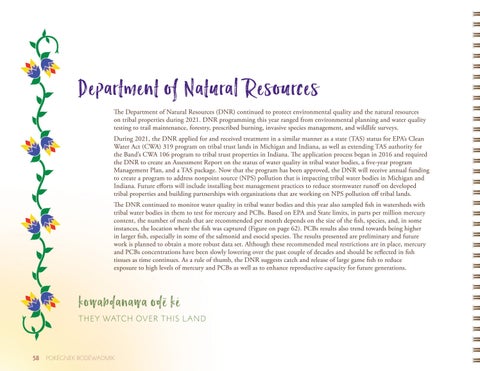Department of Natural Resources The Department of Natural Resources (DNR) continued to protect environmental quality and the natural resources on tribal properties during 2021. DNR programming this year ranged from environmental planning and water quality testing to trail maintenance, forestry, prescribed burning, invasive species management, and wildlife surveys. During 2021, the DNR applied for and received treatment in a similar manner as a state (TAS) status for EPA’s Clean Water Act (CWA) 319 program on tribal trust lands in Michigan and Indiana, as well as extending TAS authority for the Band’s CWA 106 program to tribal trust properties in Indiana. The application process began in 2016 and required the DNR to create an Assessment Report on the status of water quality in tribal water bodies, a five-year program Management Plan, and a TAS package. Now that the program has been approved, the DNR will receive annual funding to create a program to address nonpoint source (NPS) pollution that is impacting tribal water bodies in Michigan and Indiana. Future efforts will include installing best management practices to reduce stormwater runoff on developed tribal properties and building partnerships with organizations that are working on NPS pollution off tribal lands. The DNR continued to monitor water quality in tribal water bodies and this year also sampled fish in watersheds with tribal water bodies in them to test for mercury and PCBs. Based on EPA and State limits, in parts per million mercury content, the number of meals that are recommended per month depends on the size of the fish, species, and, in some instances, the location where the fish was captured (Figure on page 62). PCBs results also trend towards being higher in larger fish, especially in some of the salmonid and esocid species. The results presented are preliminary and future work is planned to obtain a more robust data set. Although these recommended meal restrictions are in place, mercury and PCBs concentrations have been slowly lowering over the past couple of decades and should be reflected in fish tissues as time continues. As a rule of thumb, the DNR suggests catch and release of large game fish to reduce exposure to high levels of mercury and PCBs as well as to enhance reproductive capacity for future generations.
kowabdanawa odë kė THEY WATCH OV ER THIS LAND
58
POKÉGNEK BODÉWADMIK






